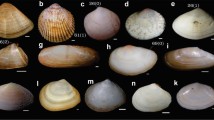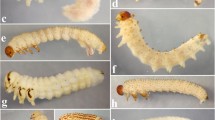Abstract
Architectonics of the leech body constitute a source of promorphological characters which have been used for modeling. A geometric model of the leech body form was applied in a phylogenetic analysis for the estimation of the utility of morphometric data in the reconstruction of the history of Hirudinida. A cladistic analysis included species representing all main ecological groups of leeches. In the analysis the morphometric data were used as non-discretized mean values and as mean values coded with the gap-weighting method. Obtained phylogenetic trees were compared with cladograms generated based on combined data sets including discrete qualitative morphological characters as well as known molecular phylogenies of leeches. The study demonstrates that the morphometric characters provide additional evidence for the confirmation of monophyletic groups within Hirudinida. Thus, the morphometric data resulting from the geometric model of the leech body form appeared to be applicable for the reconstruction of leech phylogeny.
Similar content being viewed by others
References
Aguilar-Medrano R., Frédérich B., de Luna E. & Balart E.F. 2011. Patterns of morphological evolution of the cephalic region in damselfishes (Perciformes: Pomacentridae) of the Eastern Pacific. Biol. J. Linn. Soc. Lond. 102 (3): 593–613. DOI: 10.1111/j.1095-8312.2010.01586.x
Apakupakul K., Siddall M.E. & Burreson E.M. 1999. Higher level relationships of leeches (Annelida: Clitellata: Euhirudinea) based on morphology and gene sequences. Mol. Phylogen. Evol. 12 (3): 350–359. DOI: 10.1006/mpev.1999.0639
Bielecki A. 1997. Fish leeches of Poland in relation to the Palearctic piscicolines (Hirudinea: Piscicolidae: Piscicolinae). Genus 8 (2): 223–378.
Bielecki A., Cichocka J.M., Jelen I., Swiatek P., Plachno B.J. & Pikula D. 2013a. New data about the functional morphology of the chaetiferous leechlike annelids Acanthobdella peledino, Grube, 1851 and Paracanthobdella livanowi (Epshtein, 1966) (Clitellata, Acanthobdellida). J. Morph. 275 (5): 528–539. DOI: 10.1002/jmor.20235
Bielecki A., Cichocka J.M., Swiatek P. & Gorzel M. 2013b. A new leech species (Clitellata: Hirudinida: Piscicolidae) from the Lyna River near Olsztyn, Poland. J. Parasitol. 99 (3): 467–474. DOI: 10.1645/GE-3154.1
Bielecki A., Cios S., Cichocka J.M. & Pakulnicka J. 2012. Piscicola siddalli n. sp., a leech species from the United Kingdom (Clitellata: Hirudinida: Piscicolidae). Comp. Parasitol. 79 (2): 219–230. DOI: http://dx.doi.org/10.1654/451Ll
Bielecki A. & Epshtein V.M. 1994. The theory of biological systematics and phylogeny reconstruction. Justification of the theory and systematisťs work within the area of description. Genus 5 (4): 411–421.
Bielecki A., Palińska K. & Cichocka J. 2009. Body form of leeches (Hirudinida: Piscicolidae) parasiting on fishes. Wiad. Parazytol. 55 (4): 359–365. PMID: 20209809
Bielecki A., Palińska K., Cichocka J.M., Beenen R., Jelen I. & AdamiakBrud Z. 2011. New information on the geographical distribution of Piscicolo, brylinskae Bielecki, 2001 (Hirudinea: Piscicolidae) in Poland and remarks on its systematic position. Biologia 66 (4): 654–661. DOI: 10.2478/sll 756-011-0071-9
Bielecki A. & Polok K. 2012. Genetic variation and species identi fication among selected leeches (Hirudinea) revealed by RAPD markers. Biologia 67 (4): 721–730. DOI: 10.2478/sll 756-012-0063-4
Bielecki A., Swiatek P., Cichocka J.M., Siddall M.E., Urbisz A. & Plachno B.J. 2013c. Diversity of features of the female reproductive system and other morphological characters in leeches (Clitellata, Hirudinida) in phylogenetic conception. Cladistics 30:540–554. DOI: 10.1111/cla.l2058
Borda E. & Siddall M.E. 2004. Arhynchobdellida (Annelida: Oligochaeta: Hirudinida): phylogenetic relationships and evolution. Mol. Phylogen. Evol. 30 (1): 213–225. DOI: 10.1016/j.ympev.2003.09.002
Chappill J.A. 1989. Quantitative characters in phylogenetic analysis. Cladistics 5: 217–234. DOI: 10.1111/j.1096-0031.1989. tb00487
Cichocka J.M. & Bielecki A. 2014. Metodologiczne uzasadnienie filogenetyki morfologie znej na przykladzie pijawek (Clitellata: Hirudinida) [Methodological background for morphological phylogenetics on the example of leeches (Clitellata: Hirudinida)], pp. 148-155. In: Kuczera M. (ed.), Wplyw Mlodych Naukowców na Osiątgnięcia Polskiej Nauki, 5 ed., Materialy Konferencji Mlodych Naukowców, Metodologia badań, Zakopane. ISBN: 978-83-63058-38-8
Cichocka J.M., Bielecki A. & Pikula D. 2014. Filogeneza pijawek (Clitellata: Hirudinida) w oparciu o cechy morfologiezne [Phylogeny of leeches (Clitellata: Hirudinida) based on morphometric characters]. Dokonania Mlodych Naukowców 2: 33–39.
Cranston P. & Humphries C. 1988. Cladistics and computers: a chironomid conundrum? Cladistics 4 (1): 72–92. DOI: 10.1111/j.1096-0031.1988.tb00469.x
de Bivort B.L., Clouse R.M. & Giribet G. 2010. A morphometrics based phylogeny of the temperate Gondwanan mite harvestmen (Opiliones, Cyphophthalmi, Pettalidae). J. Zool. Syst. Evol. Res. 48: 294–309. DOI: 10.1111/j.1439-0469.2009.00562.x
D’Hondt C., Schols P., Huysmans S. & Smets E. 2004. Systematic relevance of pollen and orbicule characters in the tribe Hillieae (Rubiaceae). Bot. J. Linn. Soc. 146 (3): 303–321. DOI: 10.1111/j.1095-8339.2004.00336.x
Epshtein V.M. 1969. Revizja rodov Piscicola i Cystobranchus (Hirudinea, Piscicolidae). Problemy parazitologii: Trudi VI Nauch. Konf. Parazitol. YCCP. Kiev 2: 286–287.
Epshtein V.M. 1989. Shchetinkonosnye, cherepaslťi i ryb’i piyavki mirovoy fauny (Sistemnyi podhod k klassi fikatsii i filogenii) [Chaetiferous, turtle and fish leeches of the fauna of the world (System approach to classi fication and phylogeny)]. Avtoreferat Dissertatsii na Soiskanie Uchenoy Stepeni Doktora Biologicheskikh Nauk. Abstract of Doctoral Dissertation, Zoologicheskiy Institut AN SSSR, Leningrad, 40 pp.
Felsenstein J. 1992. Review of Proceedings of the Michigan Morphometrics Workshop. Quart. Rev. Biol. 67: 418–419.
Felsenstein J. 2002. Quantitative characters, phylogenies and morphometrics, pp. 27-44. In: MacLeod N. & Forey P.L. (eds), Morphology, Shape and Pylogeny, Taylor & Francis Inc., New York, 320 pp. ISBN: 9780415240741
Feyerabend P.K. 1993. Against Method. Verso, London, UK, 279 pp. ISBN: 0860916464, 9780860916468
GarciaCruz J. & Sosa V. 2006. Coding quantitative character data for phylogenetic analysis: a comparison of five methods. Systematic Botany 31 (2): 302–309. DOI: http://dx.doi.org/ 10.1600/036364406777585739
Goloboff P., Farris J. & Nixon K. 2003. Tree analysis using new technology. Program and documentation. Distributed by the authors. http://www.zmuc.dk/public/phylogeny/ (accessed 31.06.2014)
Goloboff P.A., Mattoni C.I. & Quinteros A.S. 2006. Continuous characters analyzed as such. Cladistics 22 (6): 589–601. DOI: 10.1111/j.1096-0031.2006.00122.x
GonzálezJosé R., Escapa I., Neves W.A., Cúneo R. & Pucciarelli H.M. 2008. Cladistic analysis of continuous moduralized traits provides phylogenetic signal in Homo evolution. Nature 453: 775–779. DOI: 10.1038/nature06891
Guerrero J.A., De Luna E. & SanchezHernandez C. 2003. Morphometrics in the quantification of character statě identity for the assessment of primary homology: an analysis of character variation of the genus Artibeus (Chiroptera: Phyllostomidae). Biol. J. Linn. Soc. 80 (1): 45–55. DOI: 10.1046/J.1095-8312.2003.00218.x
Hennig W. 1966. Phylogenetic Systematics. Univ. of Illinois Press, USA, 263 pp. ISBN-10: 0252068149, ISBN-13: 978-0252068140
Humphries C.J. 2002. Homology, characters and continuous variables, pp. 8-26. In: MacLeod N. & Forey P.L. (eds), Morphology, Shape and Phylogeny, Taylor & Francis Inc., New York, 308 pp. ISBN: 0-415-24074-3.
Lipscomb D., Platnick N. & Wheeler P. 2003. The intellectual content oftaxonomy: a comment on DNA taxonomy. Trends Ecol. Evol. 18 (2): 65–66. DOI: 10.1016/S0169-5347(02)00060-5
Lohmann G.P. & Schweitzer P.N. 1990. On eigenshape analysis, pp. 147-166. In: Rohlf F.J. & Bookstein F.L. (eds), Proceedings of the Michigan morphometrics workshop, University of Michigan, Museum of Zoology Special Publication no. 2. ISBN:0-9628499-0-l
Lukin E.J. 1976. Pijavki presnykh i solenovatykh vodoiemov. Fauna SSSR, Pijavki Izdat. Nauka, Leningrad, 484 pp.
Maddison W.P. & Maddison D.R. 2011. Mesquite: A modular system for evolutionary analysis. Version 2.75. http://mesquiteproject.org/ (accessed 15.03.2012)
Mann K.H. 1962. Leeches (Hirudinea). Their Structure, Physiology, Ecology and Embryology. International Series of Monographs on Pure and Applied Biology, Vol. 11. Pergamon Press, New York, 228 pp.
Nesemann H. & Neubert E. 1999. Annelida, Clitellata: Branchiobdellida, Acanthobdellea, Hirudinea, pp. 1-178. In: Schwoerbel J. & Zwick P. (eds), Sufrwasserfauna von Mitteleuropa, Bd. 06/2, Spektrum, Heidelberg, 178 pp. ISBN-10: 3827409276, ISBN-13: 978-3827409270
Oceguera-Figueroa A., Phillips A.J., PachecoChaves B., Reeves W.K. & Siddall M.E. 2011. Phylogeny of macrophagous leeches (Hirudinea, Clitellata) based on molecular data and evaluation of the barcoding locus. Zool. Ser. 40 (2): 194–203. DOI: 10.1111/j.1463-6409.2010.00465.x
Pawlowski L.K. 1936. Pijawki (Hirudinea). Fauna Sodkowodna Polski 26. Wydawnictwo Kasy Imienia Mianowskiego Instytutu Popierania Nauki, Warszawa, 176 pp.
Perova S.N. 2011. Structural characteristics of the Caspian invader leech Archaeobdella esmonti Grimm in the Rybinsk Reservoir. Russ. J. Biol. Invas. 2(2-3): 223–226. DOI: 10.1134/S2075111711030106
Phillips A.J. & Siddall M.E. 2009. Polyparaphyly of Hirudinidae: many lineages of medicinal leeches. BMC Evol. Biol. 9: 246–256. DOI: 10.1186/1471-2148-9-246
Pimental R.A. & Riggins R. 1987. The nature of cladistics data. Cladistics 3 (3): 201–209. DOI: 10.111/j.1096-0031.1987.tb00508.x
Rae T.C. 1998. The logical basis for the use of continuous characters in phylogenetic systematics. Cladistics 14 (3): 221–228. DOI: 10.1111/j.1096-0031.1998.tb00335.x
Rambaut A. 2008. FigTree v1.1.1: Tree figure drawing tool. http://tree.bio.ed.ac.uk/software/ figtree (accessed 15.03. 2012)
Sawyer R.T. 1986. Leech Biology and Behaviour. Clarendon Press, Oxford, 1065 pp.
Schols P., D’Hondt C., Geuten K., Merckx V., Janssens S. & Smets E. 2004. MorphoCode: coding quantitative data for phylogenetic analysis. Phylolnformatics 4: 1–4.
Sereno P.C. 2007. Logical basis for morphological characters in phylogenetics. Cladistics 23 (6): 565–587. DOI: 10.1111/j.1096-0031.2007.00161.x
Siddall M.E. 2002. Phylogeny of the leech family Erpobdellidae (Hirudinida: Oligochaeta). Invertebr. Syst. 16 (1): 1–6. DOI: 10.1071/IT0101
Siddall M.E. & Burreson E.M. 1995. Phylogeny of the Euhirudinea: Independent evolution of blood feeding by leeches? Can. J. Zool. 73 (6): 1048–1064. DOI: 10.1139/z95-125
Siddall M.E. & Burreson E.M. 1996. Leeches (Oligochaeta?: Euhirudinea) their phylogeny and the evolution of live history strategies. Hydrobiologia 334 (1-3): 277–285. DOI: 10.1007/BF00017378
Siddall M.E., Burreson E.M. 1998. Phylogeny of leeches (Hirudinea) based of mitochondrial cytochrome c oxidase subunit I. Mol. Phylogen. Evol. 9 (1): 156–162. DOI: 10.1006/mpev.1997.0455
Smith T.B., Freed L.A., Lepson J.K. & Carothers J.H. 1995. Evolutionary consequences of extinctions in populations of a Hawaiian honeyereeper Vestiaria coccineo,. Conserv. Biol. 9: 107–113. DOI: 10.1046/j. 1523-1739.1995.09010107.x
Smith U.E. & Hendricks J.R. 2013. Geometrie morphometric character suites as phylogenetic data: extracting phylogenetic signál from gastropod shells. Syst. Biol. 62 (3): 366–385. DOI: 10.1093/sysbio/syt002
Swofford D.L. 2002. PAUP*. Phylogenetic Analysis Using Parsimony (*and Other Methods). Version 4. Sinauer Associates, Sunderland, Massachusetts, http://www.sinauer.com/paupphylogeneticanalysisusingparsimonyandothermethods-4-0-beta.html (accessed 12.02.2015)
Swiderski D.L., Zelditch M.L. & Fink W.L. 1998. Why morphometrics isn’t special: coding quantitative data for phylogenetic analysis. Syst. Biol. 47: 508–519.
Swiderski D.L., Zelditch M.L. & Fink W.L. 2002. Comparability, morphometrics and phylogenetic systematics, pp. 67-99. In: MacLeod N. & Forey P.L. (eds), Morphology, Shape and Phylogeny, Systematics Association Special Volume Series 64, Taylor & Francis Inc., New York, 308 pp. ISBN: 0-415-24074-3
Tautz D., Arctander P., Minelli A., Thomas R. & Vogler A. 2003. A plea for DNA taxonomy. Trends Ecol. Evol. 18 (2): 70–74. DOI: 10.1016/S0169-5347(02)00041-1
Thiele K. 1993. The holý grail of the perfect character: the cladistic treatment of morphometric data. Cladistics 9 (3): 295–304. DOI: 10.1111/j.1096-0031.1993.tb00226.x
Trontelj P. & Sket B. 2000. Molecular reassessment of some phylogenetic, taxonomie and biogeographic relationships between the leech genera Dino, and Trocheta (Hirudinea: Erpobdellidae). Hydrobiologia 438 (1-3): 227–235, DOI: 10.1023/A: 1004137300113
Trontelj P., Sket B. & Steinbrück G. 1999. Molecular phylogeny of leeches: congruence of nuclear and mitochondrial rDNA data sets and the origin of bloodsucking. J. Zool. Syst. Evol. Res. 37 (3): 141–147. DOI: 10.1111/j.1439-0469.1999.00114.x
Utevsky S.Y. & Trontelj P. 2004. Phylogenetic relationships of fish leeches (Hirudinea: Piscicolidae) based on mitochondrial DNA sequences and morphological data. Zool. Ser. 33 (4): 375–385. DOI: 10.1111/j.0300-3256.2004.00156.x
Wiens J.J. 2001. Character analysis in morphological phylogenetics: Problems and solutions. Syst. Biol. 50 (5): 689–699. DOI: 10.1080/106351501753328811
Wiens J.J. 2004. The role of morphological data in phylogeny reconstruction. Syst. Biol. 53 (4): 653–661. DOI: 10.1080/10635150490472959
Williams J.I. & Burreson E.M. 2006. Phylogeny of the fish leeches (Oligochaeta, Hirudinida, Piscicolidae) based on nuclear and mitochondrial genes and morphology. Zool. Ser. 35 (6): 627–639. DOI: 10.1111/j.1463-6409.2006.00246.x
Acknowledgements
We specially thank Dr Jolanta Szlachciak for her comments that improved the quality of this study, and two anonymous reviewers for providing suggestions that helped us to correct the manuscript. We also thank all researches who lent or gave us many leech specimens difficult to collect.
Author information
Authors and Affiliations
Corresponding author
Rights and permissions
About this article
Cite this article
Cichocka, J.M., Bielecki, A. Phylogenetic utility of the geometric model of the body form in leeches (Clitellata: Hirudinida). Biologia 70, 1078–1092 (2015). https://doi.org/10.1515/biolog-2015-0121
Received:
Accepted:
Published:
Issue Date:
DOI: https://doi.org/10.1515/biolog-2015-0121




